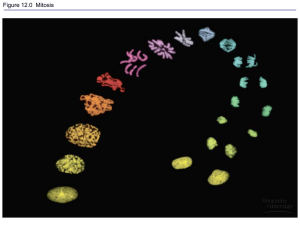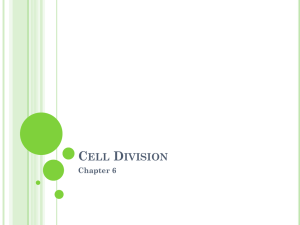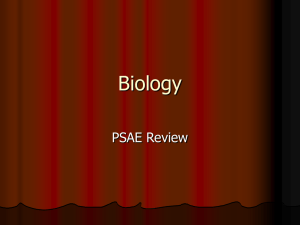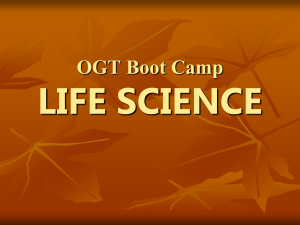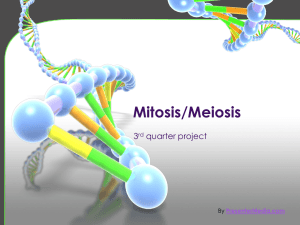3.29 Cell Reproduction I
advertisement
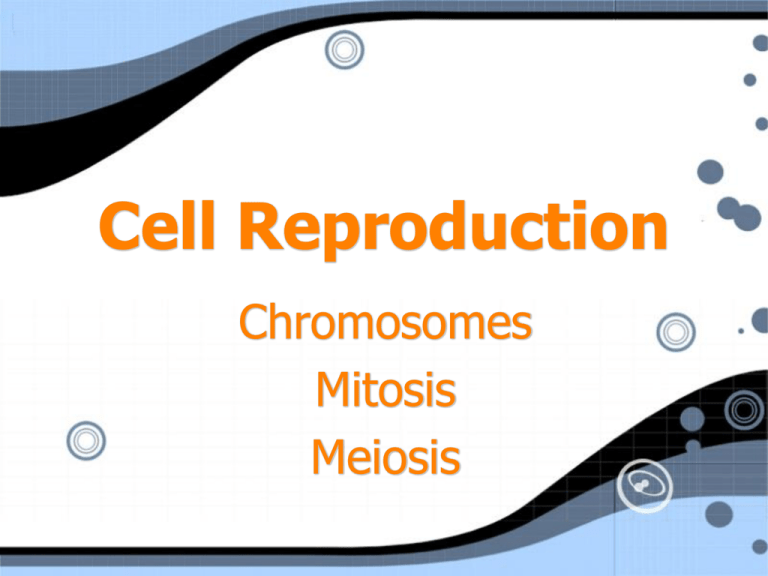
Cell Reproduction Chromosomes Mitosis Meiosis March 29th Part I • • • • • • Return Papers Notes on Chromosomes, Mitosis Cell Reproduction Handout Video: Cell Cycle, Mitosis Break Lab 11: Exercises I, III • Modeling Mitosis with Playdough • Mitosis in Whitefish Blastula • Break Chromosomes Cell Division • Cell Division is the process by which cells reproduce. • information in the cell is contained in genes → genes code for proteins → proteins carry out cellular functions • Each body cell that results from cell division must have an exact copy of the DNA in the original cell. Chromosome Structure Chromosome Structure Chromosome Structure Chromosome Structure Chromosome Number Karyotype Diploid vs. Haploid • Diploid (2n): a cell that contains both chromosomes of a homologous pair • Humans = 46 (somatic cells: body cells) • Haploid (n): a cell that has only one chromosome of each homologous pair • Humans = 23 (gametes: egg and sperm) Mitosis Mitosis • Mitosis: the division of the cell nucleus in which the chromosomes in the parent cell divide into two identical sets • In somatic cells (body cells), the number of cells is increased without changing the information contained in the DNA or the amount of DNA in those cells. Binary Fission • Binary Fission: cellular division of unicellular organisms that produces identical offspring Cell Cycle Overview Control of Cell Size • Cell Size (SA/V) • Regulatory Checkpoints - Enzymes Important Structures Equator Polar Fibers Asters Kinetechore Centrioles Kinetechore Fibers Mitosis in Plants Cleavage Furrow & Cell Plate Lab 11: Mitosis and Meiosis • Modeling Mitosis • Mitosis in Whitefish Blastula Cells Lab 11 Objectives • Understand, identify stages of mitosis and meiosis • Understand the difference between mitosis and meiosis • Identify different stages of mitosis in whitefish blastula cells March 29th Part II • Notes on Meiosis • Videos: How Meiosis Works; Stages of Meiosis • Lab 11: Exercise II • Modeling Meiosis with Playdoh • Meiosis Reinforcement Worksheet • Break Meiosis Overview Genetic Recombination • Genetic Recombination: the process that results in chromosomes being arranged in many different ways • crossing-over between homologues or chromatids • homologous pairs separate independently in meiosis I • sister chromatids separate independently in meiosis II CROSSING V E R CROSSING V E R Independent Assortment Lab 11: Mitosis and Meiosis • Modeling Meiosis March 29th Part III • Notes- Cancer: Uncontrolled Cell Growth • Video: How Cancer Spreads • Video: Cancer Cells • Lunch • Video: Cancer Warrier • Review Questions: Mitosis, Meiosis • Review for Exam II Notes: The Cell Cycle and Cancer What is Cancer? Simplest definition From the American Cancer Society “ cancer is a group of diseases characterized by uncontrolled growth and spread of abnormal cells. If the spread is not controlled, it can result in death.” Tumor – Two types: Benign (non-cancerous) – this is not cancer! – Does not spread; it can eventually become malignant in some cases. Malignant (cancerous) – this is cancer! – Has the potential to spread to other parts of body. 42 Cancer is a disease of the cell cycle. Some of the body’s cells divide uncontrollably and tumors form. Tumors in Liver Tumor in Colon Cancer: Unregulated Cell Division Quick Write ! Have you ever wondered how cancer grows? Take a close look at the cancer cell division in this realistic 3D animation. Compare and contrast healthy animal cell division to unregulated cancer cell division What would it feel like to be the nucleus of a cell that has been taken over by cancer ? DNA mutations disrupt the cell cycle. Mutations may be caused by: 1. Radiation 2. Smoking 3. Pollutants 4. Chemicals 5. Viruses While normal cells will stop dividing if there is a mutation in the DNA, cancer cells will continue to divide with mutation. Due to DNA mutations, cancer cells ignore the chemical signals that start and stop the cell cycle. Role of Cell Division in Cancer Top = normal cell division Bottom = unregulated cell division and tumor formation Malignant If tumor invades surrounding tissue (cancerous) Benign If tumor has no effect on surrounding tissue (non-cancerous) Metastatic If individual cells break away and start a new tumor elsewhere (cancerous) Image from the National Cancer Institute48 Review: The cell cycle has four phases and controls cell division Two gap or growth phases (G1 and G2) S phase DNA synthesis M phase Mitosis Interphase 49 Cell Cycle Checkpoints Three checkpoints in cell cycle – G1-S transition – G2-M transition – Exit M phase transition Checkpoints are where the cell assesses whether conditions are favorable for cell division. When the environment is not favorable (for example, when the cell’s DNA is damaged), a protein called p53 can stop the cell cycle and cause the cell to die. When the proteins that regulate the cell cycle are mutated or absent, cells can divide uncontrollably, leading to cancer. 50 Due to DNA mutations, cancer cells cannot communicate with neighboring cells. Cells continue to grow and form tumors. Skin cancer (cancer cells dividing: click on picture.) Treating Cancers Cancer treatments include drugs that can stop cancer cells from dividing. Ed Ted Video: Cancer Cell Behavior 1. 2. How many cells are in the human body ? Cancer cells are rogue clones. List and describe three mutations that allow these cells to escape the normal restrictions placed on our body’s cells. Ed Ted Video: Cancer Cell Behavior 3. Why doesn't cancer just die off after one rogue division? Most of the time, a cell detects a glitch and shuts itself down, or the system detects a troublemaker and eliminates it, but sometimes enough mutations pass the failsafes, and cancer cells divide recklessly Ed Ted Video: Cancer Cell Behavior 4. There are many actions that you can take to improve your lifestyle and reduce your risk of developing cancer. How can you take an active role in cancer prevention? Ed Ted Video: Cancer Cell Behavior 5. a. b. c. d. Which is not a routine treatment recommended to cancer treatments? Radiation Local anesthetics Chemotherapy Surgery Ed Ted Video: Cancer Cell Behavior 6. Harry is diagnosed with prostate cancer. What are some questions that he should ask his doctor? Why should he ask those questions? Ed Ted Video: Cancer Cell Behavior 7. a. b. c. d. Why are chemotherapy and radiation dangerous? Neither radiation nor chemotherapeutic drugs target only cancer cells Radiation hits whatever you point it at The bloodstream carries chemotherapeutics all over the body All of the above Ed Ted Video: Cancer Cell Behavior 8. Why are chemotherapeutic drugs generally successful against cancer cells?


